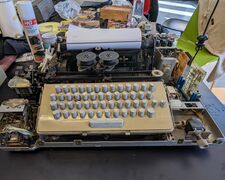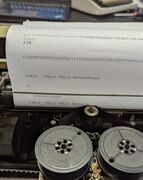User:Bnstlv/specialissue-21: Difference between revisions
| Line 71: | Line 71: | ||
<br>@nd part of the day: Writing, Revisions and Playfulness. | <br>@nd part of the day: Writing, Revisions and Playfulness. | ||
[Helmut Kopetsky] | [[Why Radio? by Helmut Kopetsky (Berlin, Germany)]] | ||
Revision as of 14:08, 17 April 2023
01 Kick-off: TTY (Working Title)
Special Issue 21 will be in collaboration with Martino (SI21 guest editor) and 7+ artists and publishers (aka guest contributors). I'm very excited for what's planned for this trimester and looking forward to meeting all of our gests and publish things on a weekly basis together.
On our first session, we talked with Martino about the history and different use cases of teletype machines, why TTY is interesting, and what's inside. Martino also mentioned some of his previous work, collective projects at Constant, BXL and more. We also discussed the format of the SI21, an on-going publishing arrangement, to be released every week. It's called Blob for now. To finish off the first day of the new trimester, we read a piece by Lori Emerson Six (Difficult and Inconvenient) Values to Reclaim the Future with Old Media.
Here's a few shots of TTY:
02 Week1: Andrea di Serego Alighieri and Martino
First part of the day | What is our relationship with writing? + Discourse on inscription
Each one of us took turns sharing what is their relationship with writing. It was interesting to talk about the differences in the approach and process between writing in our native language and in English.
<Andrea> Andrea opened the discussion by explaining a bit about his approach to writing an inscription. The definition of "inscription". Made me think of the stella we found in the Basilica in 2019, and the names inscribed on the stone. An inscription is always read, it's not present, and it has to be decypher. Involved tools, body and hand.
Заради липсата на разстония при някои от надписите, някои учени предполаагат, че е имало нужда задърлжително от някой, който да изчете текста, т.е. reading body. verbal, reaading out loud.
Емили Дикинсон, джобни писма. Във връзка с формата на текстовете, открити от древността, с различна форма при документирането им и изследването им от учени.
Labour: Woman Sitting at the Machine Thinking. Karen Brodine
Examples how to give a rhythm to a text: Norman Henry Pritchard: https://en.wikipedia.org/wiki/N._H._Pritchard
Lyn Hejinian. Her poetry plays with alphabetical order of the lines and spacing lines. https://www.poetryfoundation.org/poets/lyn-hejinian
Alice Notley: https://www.poetryfoundation.org/poets/alice-notley
Hannah Weiner: https://www.poetryfoundation.org/poets/hannah-weiner (code and text)
Kamau Brathwaite: https://www.poetryfoundation.org/poets/kamau-brathwaite 3 major crises in his own life:
- destroyed Barbados (losing memory, hard drive lost - lost his wife (she had a computer, and she initially started inscribing his work) - people entered his home to robe him, put a gun to his head and pulled the trigger, but the bullet didn't shoot; basically he "died" at this moment)
Shekspeer and the Caribean language, there's no way for him to use Carebean for the Tempest (https://en.wikipedia.org/wiki/Sycorax) because the language has to be listened, it works differently.
The audio recording of Kameu reading our loud text so to prove the idea of authentic Caribbean inscription. (audio file)
Martino
Hostorical materialism. Materialism in Media. Materialism in Marxism.
Base-Superstructure model.
Writing has become more fundamental than the language itself. We all are alphabetised.
@nd part of the day: Writing, Revisions and Playfulness.





